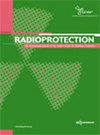喀麦隆工业放射照相中的全身职业暴露(2012 -2022)
IF 1.8
4区 医学
Q4 ENVIRONMENTAL SCIENCES
引用次数: 0
摘要
本研究分析了喀麦隆工业放射照相工人的全身剂量记录。根据2012 ~ 2022年的剂量记录,估计了年平均有效剂量和集体有效剂量。2012-2022年和2020-2022年期间受监测工人的平均年有效剂量分别为1.28毫西弗和0.41毫西弗,2012-2022年和2020-2022年期间可测量暴露工人的平均年有效剂量分别为1.61毫西弗和0.66毫西弗。2020-2022年期间受监测工作人员的平均年有效剂量低于联合国原子辐射影响科学委员会(UNSCEAR 2020/2021年报告)报告的全球值1.10。集体有效剂量在2013年和2014年达到最高,为0.131人。Sv和0.126男性。分别Sv。2012-2022年期间记录了多起高暴露病例和1起超过有效剂量限值的病例。进行的调查显示,高剂量接触主要是由高工作量、高水平工作、不遵守操作程序、设备故障或缺陷造成的。本文章由计算机程序翻译,如有差异,请以英文原文为准。
Whole Body Occupational Exposure in Industrial Radiography in Cameroon (2012 -2022)
Whole body doses records of industrial radiography workers in Cameroon were analysed in this study. Average annual effective dose and collective effective dose were estimated from dose records of 2012 to 2022. The average annual effective dose for monitored workers in the periods 2012-2022 and 2020-2022 were respectively equal to 1.28 mSv and 0.41mSv, and the average annual effective dose for measurably exposed workers in the periods 2012-2022 and 2020-2022 were respectively equal to 1.61 mSv and 0.66 mSv. The average annual effective dose for monitored workers in the period 2020-2022 is lower than the global value of 1.10 reported by the United Nations Scientific Committee on the Effects of Atomic Radiation (UNSCEAR 2020/2021 Report). The highest collective effective doses were obtained in 2013 and 2014 and were equal to 0.131 man.Sv and 0.126 man.Sv respectively. Many cases of high exposures and one case of effective dose limit exceeded were recorded during the period 2012-2022. Investigations carried out showed that high exposures were mainly caused by high workloads, working in elevated levels, failure to follow operational procedures, equipment malfunction or defect.
求助全文
通过发布文献求助,成功后即可免费获取论文全文。
去求助
来源期刊

Radioprotection
ENVIRONMENTAL SCIENCES-PUBLIC, ENVIRONMENTAL & OCCUPATIONAL HEALTH
CiteScore
3.30
自引率
54.50%
发文量
35
审稿时长
>12 weeks
期刊介绍:
Radioprotection publishes articles on all aspects of radiological protection, including non-ionising as well as ionising radiations. Fields of interest range from research, development and theory to operational matters, education and training. The very wide spectrum of its topics includes (theoretical and practical aspects): dosimetry, instrument development, specialized measuring techniques, epidemiology, biological effects (in vivo and in vitro) and risk and environmental impact assessments.
 求助内容:
求助内容: 应助结果提醒方式:
应助结果提醒方式:


